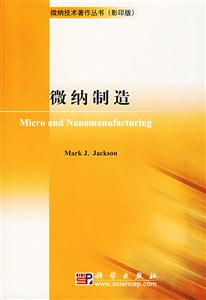扫一扫
关注中图网
官方微博
本类五星书更多>
-
>
决战行测5000题(言语理解与表达)
-
>
软件性能测试.分析与调优实践之路
-
>
第一行代码Android
-
>
深度学习
-
>
Unreal Engine 4蓝图完全学习教程
-
>
深入理解计算机系统-原书第3版
-
>
Word/Excel PPT 2013办公应用从入门到精通-(附赠1DVD.含语音视频教学+办公模板+PDF电子书)
微纳制造-(影印版) 版权信息
- ISBN:9787030182432
- 条形码:9787030182432 ; 978-7-03-018243-2
- 装帧:暂无
- 册数:暂无
- 重量:暂无
- 所属分类:>
微纳制造-(影印版) 内容简介
纳米技术是当前科学研究与工业开发的热门领域之一。本书全面阐述了微纳器件的设计和制造方面的知识,以及在设计和制造时所要考虑的诸多因素。书中涵盖了多种制造技术,包括微纳制造技术、体和表面微加工技术、LiGA技术、薄膜沉积技术、纳加工技术等。
本书内容丰富,讲解透彻,是一本相关领域电子工程师、材料科研工作者开发微纳米材料应用的全面的指南,同时也可作为微纳米机械和微纳米技术专业研究生的参考书。
微纳制造-(影印版) 目录
Preface
1. Principles of Micro-and Nanofabrication
1.1 Introduction
1.2 Material Removal Rates
1.3 Conclusions
1.4 Problems
References
2. Microfabrication Using X-ray Lithography
2.1 Introduction
2.2 X- ray Lithography
2.3 Synchrotron Radiation
2.4 Microfabrication Process
2.5 Methods of Resist Application
2.6 Exposure
2.7 Problems
References
3. Manufacturing High Aspect Ratio Microstructures
3.1 I ntrod uction
3.2 Dry Etching
3.3 Plasma Etching Processes
3.4 Characteristics of the Plasma
3.5 Etching of Microstructures
3.6 Micromachining High Aspect Ratio
Microstructures
3.7 Micromolding
3.8 Micromolding Processes
3.9 Micromolding Tools
3.10 Micromold Design
3.11 MicromoldingApplications
3.12 Limitations of Micromolding
3.13 Fabrication of Moving Microstructures
3.14 Conclusions
3.15 Problems
References
4. Meso-micromachining
4.1 Introduction
4.2 Size Effects in Micromachining
4.3 Mechanism for Large Plastic Flow
4.4 Inhomogeneous Microstrains
4.5 Origins of the Size Effect
4.6 Meso-machining Processes
4.7 Problems
References
5. Mechanical Micromachining
5.1 Introduction
5.2 Microfluidic Systems
5.3 Theory of Micromachining
5.4 Experimental Micromachining
5.5 Micromachining Tool Design
5.6 High-Speed Air Turbine Spindles
5.7 Mechanical Design of Rotors
5.8 Discussion
5.9 Conclusions ,
5.10 Future Developments
5.11 Problems
References
6. Microgrinding
6.1 Introduction
6.2 Grinding Wheels
6.3 Conventional Grinding Processes
6.4 Precision Grinding Processes
6.5 Ultra Precision Grinding
6.6 Conclusions
6.7 Problems
References
7. Diamond Micro Cutting Tools
7.1 Introduction
7.2 Properties of Diamond
7.3 History of Diamond
7.4 CVD Diamond Technology
7.5 CVD Diamond Processes
7.6 Treatment of Substrate
7.7 Modification of HFCVD Process
7.8 Nucleation and Growth
7.9 Deposition on 3-D Substrates
7.10 Wear of Diamond
7.11 Time-Modulated CVD Diamond
7.12 Conclusions
7.13 Problems
References
8. Laser Micro- and NanofabricaUon
6.1 Introduction
8.2 Laser Fundamentals
8.3 Laser Microfabrication
8.4 Laser Nanofabrication
8.5 Conclusions
8.6 Problems
References
9. Micromachining Using Water Droplets
9.1 Introduction
9.2 Theory of Pulsed Liquid Impact
9.3 Impact by Water Drops
9.4 Modeling Machining Thresholds
9.5 Comparative Results
9.6 Material Removal Rates
9.7 Design of Water-Based Tools
9.8 Analysis of Space Frame
9.9 Mode Shapes of Tetrahedral Structure
9.10 Conclusions
9.11 Problems
References
10. Diamond Nanogrinding
10.1 Introduction
10.2 Piezoelectric Nanogrinding
10.3 Stress Analysis in Nanogrinding Grains
10.4 Fracture Dominated Wear Model
10,5 Nanogrinding
10.6 Porous Nanogrinding Tools
10.7 Laser Dressing of Tools
10,8 Future Directions
10.9 Problems
References
11. Nanomachining
11.1 Introduction
11.2 Nanometric machining
11.3 Theoretical Basis of Nanomachining
11.4 Implementation
11.5 Conclusions
11.6 Problems
References
12. Micro- and Nanomanufacturing
12.1 Introduction
12.2 Micromanufacturing
12.3 Nanomanufacturing
12.4 Commercialization Issues of Micro and Nanotechnologies
12.5 Future Developments
12.6 Problems
References
Subject Index
1. Principles of Micro-and Nanofabrication
1.1 Introduction
1.2 Material Removal Rates
1.3 Conclusions
1.4 Problems
References
2. Microfabrication Using X-ray Lithography
2.1 Introduction
2.2 X- ray Lithography
2.3 Synchrotron Radiation
2.4 Microfabrication Process
2.5 Methods of Resist Application
2.6 Exposure
2.7 Problems
References
3. Manufacturing High Aspect Ratio Microstructures
3.1 I ntrod uction
3.2 Dry Etching
3.3 Plasma Etching Processes
3.4 Characteristics of the Plasma
3.5 Etching of Microstructures
3.6 Micromachining High Aspect Ratio
Microstructures
3.7 Micromolding
3.8 Micromolding Processes
3.9 Micromolding Tools
3.10 Micromold Design
3.11 MicromoldingApplications
3.12 Limitations of Micromolding
3.13 Fabrication of Moving Microstructures
3.14 Conclusions
3.15 Problems
References
4. Meso-micromachining
4.1 Introduction
4.2 Size Effects in Micromachining
4.3 Mechanism for Large Plastic Flow
4.4 Inhomogeneous Microstrains
4.5 Origins of the Size Effect
4.6 Meso-machining Processes
4.7 Problems
References
5. Mechanical Micromachining
5.1 Introduction
5.2 Microfluidic Systems
5.3 Theory of Micromachining
5.4 Experimental Micromachining
5.5 Micromachining Tool Design
5.6 High-Speed Air Turbine Spindles
5.7 Mechanical Design of Rotors
5.8 Discussion
5.9 Conclusions ,
5.10 Future Developments
5.11 Problems
References
6. Microgrinding
6.1 Introduction
6.2 Grinding Wheels
6.3 Conventional Grinding Processes
6.4 Precision Grinding Processes
6.5 Ultra Precision Grinding
6.6 Conclusions
6.7 Problems
References
7. Diamond Micro Cutting Tools
7.1 Introduction
7.2 Properties of Diamond
7.3 History of Diamond
7.4 CVD Diamond Technology
7.5 CVD Diamond Processes
7.6 Treatment of Substrate
7.7 Modification of HFCVD Process
7.8 Nucleation and Growth
7.9 Deposition on 3-D Substrates
7.10 Wear of Diamond
7.11 Time-Modulated CVD Diamond
7.12 Conclusions
7.13 Problems
References
8. Laser Micro- and NanofabricaUon
6.1 Introduction
8.2 Laser Fundamentals
8.3 Laser Microfabrication
8.4 Laser Nanofabrication
8.5 Conclusions
8.6 Problems
References
9. Micromachining Using Water Droplets
9.1 Introduction
9.2 Theory of Pulsed Liquid Impact
9.3 Impact by Water Drops
9.4 Modeling Machining Thresholds
9.5 Comparative Results
9.6 Material Removal Rates
9.7 Design of Water-Based Tools
9.8 Analysis of Space Frame
9.9 Mode Shapes of Tetrahedral Structure
9.10 Conclusions
9.11 Problems
References
10. Diamond Nanogrinding
10.1 Introduction
10.2 Piezoelectric Nanogrinding
10.3 Stress Analysis in Nanogrinding Grains
10.4 Fracture Dominated Wear Model
10,5 Nanogrinding
10.6 Porous Nanogrinding Tools
10.7 Laser Dressing of Tools
10,8 Future Directions
10.9 Problems
References
11. Nanomachining
11.1 Introduction
11.2 Nanometric machining
11.3 Theoretical Basis of Nanomachining
11.4 Implementation
11.5 Conclusions
11.6 Problems
References
12. Micro- and Nanomanufacturing
12.1 Introduction
12.2 Micromanufacturing
12.3 Nanomanufacturing
12.4 Commercialization Issues of Micro and Nanotechnologies
12.5 Future Developments
12.6 Problems
References
Subject Index
展开全部
书友推荐
- >
罗曼·罗兰读书随笔-精装
罗曼·罗兰读书随笔-精装
¥31.9¥58.0 - >
【精装绘本】画给孩子的中国神话
【精装绘本】画给孩子的中国神话
¥19.3¥55.0 - >
史学评论
史学评论
¥22.7¥42.0 - >
伊索寓言-世界文学名著典藏-全译本
伊索寓言-世界文学名著典藏-全译本
¥9.3¥19.0 - >
有舍有得是人生
有舍有得是人生
¥17.1¥45.0 - >
巴金-再思录
巴金-再思录
¥14.7¥46.0 - >
山海经
山海经
¥19.7¥68.0 - >
月亮与六便士
月亮与六便士
¥15.1¥42.0
本类畅销
-
”互联网+“时代计算机算法的应用及其实践研究
¥19.9¥59 -
微服务设计
¥52.8¥69 -
图说深度学习:用可视化方法理解复杂概念
¥109¥188 -
计算机基础
¥17.2¥31 -
改变未来的九大算法
¥50¥68 -
生成式AI入门与AWS实战
¥77.8¥99.8





















